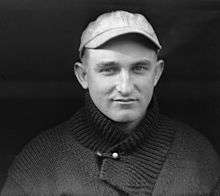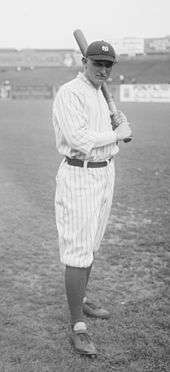Carl Mays
| Carl Mays | |||
|---|---|---|---|
 | |||
| Pitcher | |||
|
Born: November 12, 1891 Liberty, Kentucky | |||
|
Died: April 4, 1971 (aged 79) El Cajon, California | |||
| |||
| MLB debut | |||
| April 15, 1915, for the Boston Red Sox | |||
| Last MLB appearance | |||
| September 24, 1929, for the New York Giants | |||
| MLB statistics | |||
| Win–loss record | 207–126 | ||
| Earned run average | 2.92 | ||
| Strikeouts | 862 | ||
| Teams | |||
| |||
| Career highlights and awards | |||
| |||
Carl William Mays (November 12, 1891 – April 4, 1971) was a right-handed pitcher in Major League Baseball from 1915 to 1929.[1] Although he won over 200 games, 27 in 1921 alone, and was a member of three world championship teams, Mays is primarily remembered for throwing the beanball that killed Ray Chapman of the Cleveland Indians on August 16, 1920. Chapman became the only Major League player to die as a direct result of an on-field injury.[2][3]
Playing career
According to his World War I draft card, Carl William Mays was born November 12, 1891 in Atterson, Kentucky. His father was a Methodist minister named William Henry Mays. Carl had a strict upbringing as a child. When Mays was 12, his father died. Mays internalized his grief, settling into a surly persona. His best personal support group was a couple named Pierce and Genevieve Mays, who were related to Carl, and served as a surrogate uncle and aunt.[4] As a professional baseball player, he had few friends among in the baseball world. In part because of his strict Methodist upbringing, Mays refused to pitch on Sundays, as did legendary pitcher Christy Mathewson, .[5]
Mays was nicknamed "Sub", a reference to his submarine pitching motion,[2] and he was known to throw a spitball. The pitch was legal at the time of the Chapman incident, but Chapman's death was partly responsible for its ban in Major League Baseball. Mays was also known for a habit of throwing inside to any batter who hugged the plate; despite a stellar win/loss record, he was typically among the American League leaders in hit batsmen.[5]

In 1915, while a member of the Boston Red Sox, Mays was in a heated confrontation with Ty Cobb of the Tigers. Mays threw at Cobb each time he came to bat. In the eighth inning, after a close pitch, Cobb threw his bat in Mays' direction, calling him a "no good son of a bitch." Mays responded by calling Cobb a "yellow dog."[6] After order was restored, Mays hit Cobb directly on the wrist. The Tigers won the game 6–1[6] and the incident cemented Mays' reputation as a head hunter.[6]
Death of Ray Chapman
The Yankees were trailing the Indians when Ray Chapman came to the plate in the fifth inning on August 16, 1920. Mays was pursuing his 100th career win that day. Chapman had a sacrifice bunt in the first inning and popped up to Yankee first baseman Wally Pipp in the third.[7] Angered that Chapman was crowding the plate, Mays let loose with a high fastball that he claimed was in the strike zone but that Chapman apparently never saw. The impact of the ball striking Chapman in the head was so loud that Mays, thinking it had hit Chapman's bat and was in play, caught the ball as it bounced onto the field and threw it to Pipp at first base. Chapman, trying to take his base after the hit by pitch, fell to the ground twice and was unable to get up. Cleveland teammate Tris Speaker raced from the on deck circle to check on Chapman. He was joined by several players from the Indians and Yankees. Mays, however, never left the mound.[7]
Chapman was taken to a hospital, where surgeons operated and discovered a skull fracture. He initially seemed to rally after the surgery but died early in the morning on the following day. Mays stayed in the game and continued to pitch until being replaced in the ninth inning. Cleveland won the game 4-3. The New York District Attorney determined that the incident was an accident, and no charges were filed.[8]
In an interview three months after Chapman's death, Mays expressed regret for the outcome, but stated that he did not feel any guilt because he had not hit Chapman on purpose.[9]
Later career
Mays enjoyed his best season in 1921, when he led the American League in wins (27), innings pitched (336.2), games pitched (49), and winning percentage (.750). However, that same season Mays, pitching then for the Yankees, played in a World Series that others later accused him of helping to throw, bringing back memories of the Black Sox scandal from just two years prior. These rumors were never proven, but they persisted long enough that, combined with an already negative reputation among other players both from the Chapman incident and from having a personality that few found agreeable, he was never elected to the Baseball Hall of Fame despite having lifetime statistics comparable to some other pitchers who were.[10]
In a 15-year career with the Boston Red Sox, New York Yankees, Cincinnati Reds, and New York Giants, Mays compiled a 207–126 record with 29 shutouts, 862 strikeouts and a 2.92 earned run average when the league average was 3.48.[1] He won twenty or more games five times.[1] He was also noted for his skills with a bat, hitting five home runs, recording 110 runs batted in, and sporting a lifetime .268 batting average—an unusually high mark for a pitcher. Mays is the only Red Sox pitcher to toss two nine-inning complete game victories on the same day, as he bested the Philadelphia Athletics 12–0 and 4–1 on August 30, 1918.[11] Those wins put the Red Sox one step from clinching the league championship, as they led Cleveland by 3 1/2 games with 4 remaining to play.
Later years
After his playing career, was the owner and operator of a baseball school in Oregon; among his most notable attendees was Johnny Pesky.[10] Mays also worked as a scout for the Cleveland Indians, Milwaukee and Atlanta Braves, and Kansas City Royals. In addition, his stepson Jerry Bartow coached baseball at Hoover High School in San Diego, and each spring Mays made the trip from Oregon to volunteer as a mentor and assistant coach. In an interview, Mays said he especially enjoyed working with young pitchers, but that he regarded his most important task as teaching members of the team how to play the game safely.
He died in El Cajon, California and is buried in River View Cemetery, Portland, Oregon (Sec. 13, Lot 49, Sp. 7). His distant cousin, Joe Mays, was a Major League pitcher from 1999 to 2006.
Family
In 1918, Mays married Marjorie Fredricka Madden, a graduate of the New England Conservatory of Music who he had met during his rookie season. They were the parents of two children, Carl Jr. (1925-2017) and Elizabeth (Betty). He was survived by a second wife, Esther Ugstead (1907-1990).
Legacy
In August 2008, Mays was one of the ten former players who began their careers before 1943 to be considered by the Veterans Committee for induction into the National Baseball Hall of Fame in 2009. He was named on only about 25 percent of the ballots, so he was not selected for induction.
Further reading
The book The Pitch That Killed, by Mike Sowell, is a history of the Chapman-Mays events.
The historical novel, The Curse of Carl Mays, by Howard Camerik, also recounts the history of the incident.
The children's book, Ray and Me by Dan Gutman, tells of Joe Stoshack and his journey to save Ray's life from Mays' "killer" pitch.
The book 1921: The Yankees, the Giants, and the Battle for Baseball Supremacy in New York by Lyle Spatz, Steve Steinberg, Charles C. Alexander, takes a look at how Mays had social problems with his teammates and how that actually led him to be sold to the Yankees from the Red Sox.
See also
References
- 1 2 3 "Carl Mays Statistics and History – Baseball-Reference.com". Baseball-Reference.com. Retrieved 23 April 2015.
- 1 2 Carl Mays: My Pitch That Killed Chapman Was A Strike! by Phyllis Propert, Baseball Digest, July 1957, Vol. 16, No. 6, ISSN 0005-609X
- ↑ "The Death of Ray Chapman", The New York Times, August 17, 1920
- ↑ Deveney, Sean. The Original Curse (McGraw-Hill, 2010), pp. 146–157.
- 1 2 "TheDeadballEra.com :: THE MAYS/CHAPMAN INCIDENT: THE PARTICIPANT'S". thedeadballera.com. Retrieved 23 April 2015.
- 1 2 3 "TheDeadballEra.com :: THE MAYS/CHAPMAN INCIDENT: PRELUDE TO DISASTER". thedeadballera.com. Retrieved 23 April 2015.
- 1 2 "TheDeadballEra.com :: THE MAYS/CHAPMAN INCIDENT: THE INCIDENT". thedeadballera.com. Retrieved 23 April 2015.
- ↑ Ron Elliot, Historic Kentucky People and Places, Ray Chapman's Last Time at Bat, Courtesy of Carl Mays, accessed January 31, 2013
- ↑ Guerrieri, Vince (January 2, 2015) [November 1920]. "Carl Mays: My Attitude Toward the Unfortunate Chapman Matter". Did The Tribe Win Last Light? Originally Published in Baseball magazine. Cleveland, OH. Retrieved May 27, 2018.
- 1 2 "Tragic Pitch Recalled By Carl Mays", by Jack Murphy, Baseball Digest, May 1971, Vol. 30, No. 5, ISSN 0005-609X
- ↑ "The 1918 Boston Red Sox Game Log". retrosheet.org. Retrieved 23 April 2015.
External links
| Wikimedia Commons has media related to Carl Mays. |
- Career statistics and player information from Baseball-Reference, or Baseball-Reference (Minors)
- The Death of Ray Chapman – NY Times, 18 August 1920
- Trouble Followed Storm-Center Mays; Sore Arm Made Him Pitch Underhand, by Harry Grayson, June 16, 1943
- Carl Mays at Find a Grave
